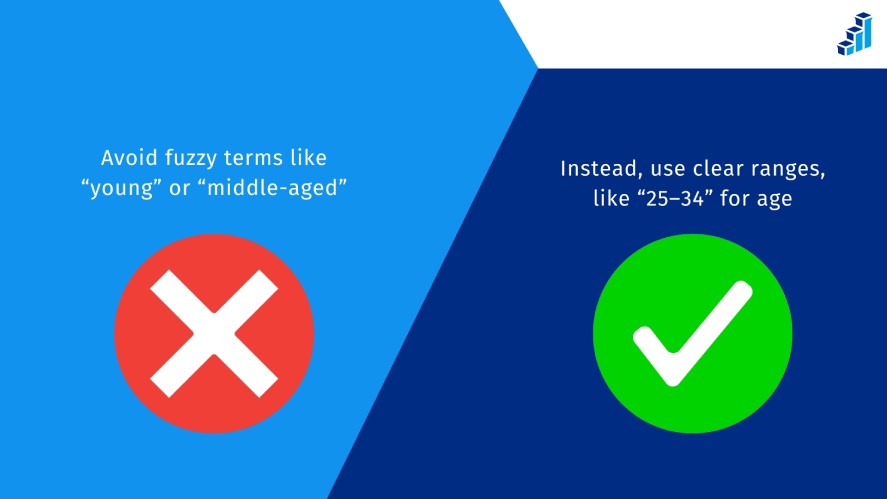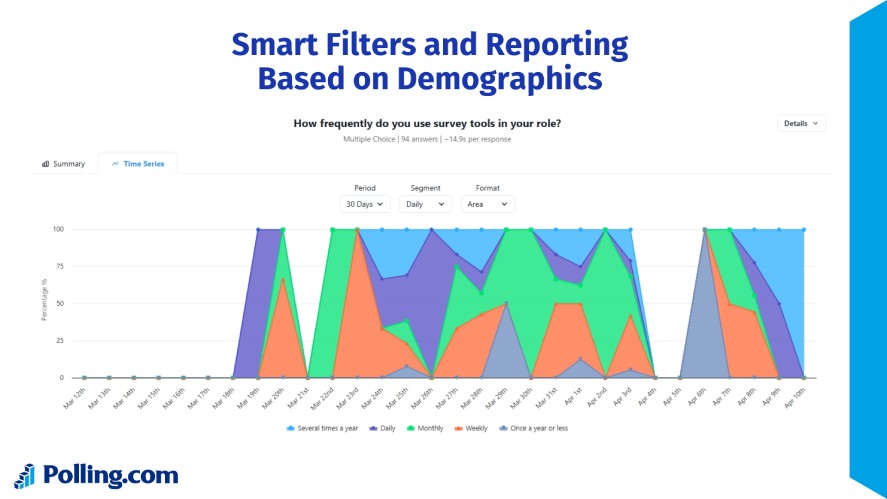
Demographic Questions: How to Write Them for Better Survey Segmentation
Ever wonder why some businesses seem to know their customers like old friends? It’s all about demographic questions that peel back the layers of who people are, making surveys way more than just checkboxes.
These questions let you slice and dice data for customer segmentation, so you can tailor everything from ads to products with laser focus.
Polling.com’s slick survey tools make this a breeze, helping you craft demographic survey questions that unlock game-changing insights.
This article will unpack how to write demographic questions that turn your surveys into goldmines of insight.
What Are Demographic Questions?
Picture demographic questions as the ID card of your survey respondents. It contains basic facts like age, gender, or where they live.
They’re built to sort people into neat groups for customer segmentation, giving you a clear map of who’s answering your survey questions.
Think age brackets, income levels, education, location, or ethnicity; each one’s a puzzle piece for understanding behavior.
Unlike psychographic questions, which dig into feelings or hobbies, common demographic questions stick to the concrete stuff, ensuring survey reliability.
Why Demographic Questions Are Crucial for Data Segmentation
Surveys without demographic questions are like cooking without spices; they’re flat and forgettable.
Customer segmentation spices things up, breaking survey responses into groups to spot trends, like how 200 older customers might love your eco-friendly packaging.
This powers everything from marketing (think ads that hit home) to political polling (knowing which regions lean left) or product tweaks (like budget-friendly options for students).
Polling.com’s survey tools let you filter demographic survey questions in real time, so you see exactly who’s saying what. With these insights, companies can come up with strategies that absolutely crush it.
Best Practices for Writing Demographic Questions
Crafting demographic questions that resonate with respondents is an art, ensuring survey responses are both useful and respectful for customer segmentation.
Nobody wants a survey that feels like a tax form, so these survey best practices keep things engaging and effective.

Use Inclusive and Respectful Language
Words matter in demographic questions, and inclusive language builds trust, especially for sensitive topics like gender or ethnicity.
Phrasing like “What gender do you identify as?” welcomes everyone, boosting survey reliability by encouraging honest answers.
Avoid Leading or Biased Questions
Neutral survey questions are key to avoiding skewed data that messes up customer segmentation.
Asking “How much do you earn?” instead of “Are you in a high-income bracket?” prevents bias and keeps responses honest.
Provide Clear Answer Options
Clear answer choices, like age or income ranges, make demographic questions easy to answer, improving survey responses.
For example, “Select your age: 18–24, 25–34…” avoids confusion and speeds things up.
Vague options are a snooze-fest and drive people away.
Consider Survey Fatigue and Question Length
Short, focused demographic questions prevent survey fatigue, keeping respondents engaged for better survey reliability.
Asking only what’s needed, like skipping marital status for a product survey, lifts completion rates.
Include “Prefer Not to Say” Options
Privacy is king, and “prefer not to say” options in demographic survey questions respect respondents, boosting credibility and trust.
Without them, people might skip or lie, hurting customer segmentation.
When Should You Ask Demographic Questions in a Survey?
Timing is everything in survey design, especially when it comes to survey question types like demographics.
Ask too early, and you risk scaring respondents away. Ask too late, and you might miss critical context that influences how people answer.
So, what’s the best time to collect personal information fields like age, gender, race, or income?
Beginning: Good for Segmentation, Risky for Drop-Offs
Placing demographic segmentation questions at the start of your survey can help with audience profiling early on. This is useful if you want to branch questions or personalize experiences based on respondent background information.
However, there’s a trade-off: starting with personal or sensitive topics like socioeconomic data collection or race and ethnicity in surveys can lead to early drop-offs, especially if respondents feel it’s intrusive or irrelevant.
Use this approach when:
- The survey is short (under 5 minutes)
- You need to dynamically filter questions
- The audience expects it (e.g., academic or policy research)
End: Safer for Completion, Better for Trust
Placing participant characteristics at the end is a common best practice for general surveys. By then, the respondent is already invested, and more likely to complete even sensitive fields.
This approach works well for:
- Consumer feedback and product research
- Brand perception studies
- Any situation where survey respondent insights are more valuable when the full survey is completed
If you must ask demographics early, start with less sensitive age and gender questions, and gradually move into more personal topics. Also, clearly explain why you’re collecting the data, as this builds trust and increases completion rates.
By understanding survey question types and their ideal placement, you can get cleaner, more complete data without sacrificing the respondent experience.
Pro Tip: Use progressive disclosure, showing only a few personal information fields at a time to reduce cognitive overload and improve response quality.
Sample Demographic Questions by Category
Demographic questions give you a toolkit for sharp customer segmentation, tailored to your survey’s goals. These questions follow survey best practices, balancing clarity and sensitivity.
Here’s a quick lineup to spark your next survey questions masterpiece.
Age
- What is your age range? (e.g., 18–24, 25–34, 35–44, 45–54, 55+)
- How old are you? (Open-ended, if precise data needed)
- Which generation do you belong to? (e.g., Gen Z, Millennial, Gen X, Boomer)
- Are you 18 or older? (Yes/No)
Gender
- What gender do you identify as? (e.g., Male, Female, Non-binary, Other)
- How would you describe your gender identity? (Open-ended)
- Select your gender: (Male, Female, Transgender, Prefer to self-describe, Prefer not to say)
- Are you comfortable sharing your gender? (Yes/No)
Education
- What is your highest level of education? (e.g., High school, Bachelor’s, Master’s, Doctorate)
- Have you completed college? (Yes/No)
- What type of school did you last attend? (e.g., Public, Private, Trade)
- Are you currently a student? (Yes/No)
Income
- What is your annual household income? (e.g., Under $25K, $25K–$50K, $50K–$100K, $100K+)
- How would you describe your income level? (e.g., Low, Middle, High)
- Do you feel financially secure? (Yes/No)
- Are you the primary earner in your household? (Yes/No)
Location
- What is your zip code? (Open-ended)
- In which country do you reside? (e.g., USA, Canada, UK, Other)
- What type of area do you live in? (e.g., Urban, Suburban, Rural)
- Which state or region are you from? (e.g., CA, NY, Midwest)
Employment Status
- What is your current employment status? (e.g., Full-time, Part-time, Unemployed, Retired)
- Are you self-employed? (Yes/No)
- What industry do you work in? (e.g., Tech, Healthcare, Retail)
- Do you work remotely? (Yes/No)
Ethnicity
- How would you describe your ethnicity? (e.g., Asian, Black, Hispanic, White, Other)
- What is your cultural background? (Open-ended)
- Do you identify with a specific ethnic group? (Yes/No)
- Select your ethnicity: (List regional options, e.g., African American, South Asian)
Marital Status
- What is your marital status? (e.g., Single, Married, Divorced, Widowed)
- Are you in a committed relationship? (Yes/No)
- Do you live with a partner? (Yes/No)
- Have you ever been married? (Yes/No)
Household Size
- How many people live in your household? (e.g., 1, 2, 3–4, 5+)
- Do you live alone? (Yes/No)
- How many children live with you? (e.g., 0, 1, 2, 3+)
- What is your household type? (e.g., Family, Roommates, Solo)
Mistakes to Avoid When Writing Demographic Questions
Sloppy demographic questions can tank your survey, ruining survey responses and customer segmentation.
Nobody loves a survey that feels like an interrogation, so dodging these common pitfalls is key to keeping respondents happy and data clean.
Asking Too Many Demographic Questions at Once
Piling on demographic survey questions like age, income, and education all at once overwhelms respondents. It’s like asking someone their life story before saying hello, and people may bail.
Instead, focus on what’s essential for customer segmentation, like location for a retail survey.
Using Vague Categories
Fuzzy terms like “young” or “middle-aged” in demographic questions confuse respondents, muddying survey reliability.

Without clear ranges, like “25–34” for age, you’ll get inconsistent data that’s useless for customer segmentation.
Forcing Responses on Sensitive Topics
Demanding answers on touchy subjects like income or ethnicity drives respondents away or leads to fake survey responses, wrecking survey reliability.
Always include “prefer not to say” to respect privacy and boost trust.
How Polling.com Makes Demographic Segmentation Easier
Demographic questions are only as good as the tools behind them, and Polling.com’s survey platform turns survey responses into sharp customer segmentation insights.
Unlike clunky alternatives, it’s built to make crafting and analyzing survey questions feel like a walk in the park. Here’s how Polling.com helps you segment smarter.
Customizable Demographic Templates
Polling.com’s survey tools offer ready-to-go demographic survey questions templates, letting you tailor categories like age or income to your audience in minutes.
Whether you need broad ranges or niche options, these templates ensure survey reliability without starting from scratch. Also, you can tweak these sample demographic questions to fit any goal effortlessly.
Smart Filters and Reporting Based on Demographics
Polling.com’s smart filters slice survey responses by demographic questions, like filtering 500 responses to show only 25–34-year-olds’ preferences, powering precise customer segmentation.

Its real-time reporting dashboards visualize trends, making insights pop. It turns raw types of survey questions data into actionable strategies fast.
Comparison with Other Survey Platforms
Compared to SurveyMonkey’s complex setups or Google Forms’ bare-bones options, Polling.com’s survey platform balances power and simplicity for demographic questions for survey.
SurveyMonkey offers robust analytics but can overwhelm newbies, while Google Forms lacks advanced customer segmentation filters.
Polling.com stands in between. Its intuitive design lets you craft common demographic questions without a PhD in data science. It’s a go-to for clients needing survey best practices without the hassle.
Ease-of-Use, GDPR Compliance, and Analytics Dashboard
Polling.com’s drag-and-drop interface makes building demographic survey questions a breeze, even for beginners, while its GDPR-compliant survey tools keep data secure.
The analytics dashboard delivers clear visuals, like pie charts for survey responses, to drive customer segmentation.
This survey platform checks every box for survey reliability and ease.
Conclusion
Demographic questions are the backbone of smart survey design, unlocking customer segmentation that fuels better products, marketing, and decisions.
To integrate them naturally, ask only what matters, place sensitive survey questions at the end, and always offer opt-outs for survey reliability.
Polling.com’s survey tools make this a cinch, helping you craft examples of demographic questions that work. Try Polling.com’s free survey builder to start segmenting smarter today.
